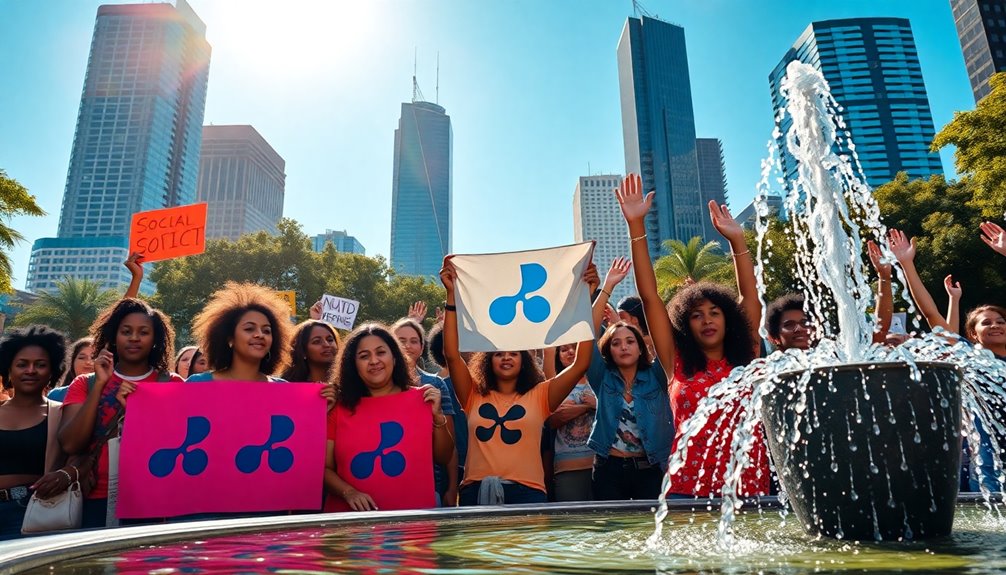Ripple's bid for regulatory approval of its RLUSD stablecoin could revolutionize finance. By securing a limited purpose trust charter, Ripple aims to comply with stringent NYDFS regulations, enhancing trust in the digital asset sector. With the stablecoin market growing rapidly, RLUSD could carve out a significant niche, especially as businesses increasingly adopt stablecoins. Regulatory challenges still loom, particularly from the SEC over XRP's status. However, if Ripple navigates these hurdles, RLUSD could facilitate seamless, secure transactions on a global scale, reshaping financial operations. There's more to explore regarding its implications for the market dynamics and user experience.
Key Takeaways
- Ripple's RLUSD stablecoin seeks NYDFS approval, potentially revolutionizing finance through regulatory compliance and innovative blockchain integration.
- The stablecoin market is growing, with Ripple aiming to capture market share amid increasing adoption and competition from established players like Tether and USDC.
- Ripple's legal battles with the SEC over XRP's status create uncertainty but may pave the way for clearer regulations benefiting RLUSD's launch.
- Smart contracts on the XRP Ledger enhance RLUSD's utility, potentially driving demand and increasing Ripple's market capitalization in the evolving crypto landscape.
- Strategic partnerships and liquidity support are crucial for RLUSD's success, ensuring stability and integration with traditional finance systems for broader acceptance.
Approval and Regulatory Landscape

Ripple is gearing up to navigate the complex approval and regulatory landscape as it seeks the green light from the New York Department of Financial Services (NYDFS) for its RLUSD stablecoin.
To kick off the process, you'll need to secure a limited purpose trust charter under the New York Banking Law, which means presenting a thorough business plan and product offerings for scrutiny.
Before launching RLUSD, you must obtain written approval from the NYDFS, ensuring compliance with various regulatory requirements. This includes adopting clear redemption policies and backing the stablecoin with a reserve of assets equal to its outstanding units.
Regulators will evaluate risks related to cybersecurity, network design, and consumer protection, among other factors. Stablecoins are extensively used for payments and trading due to their price stability, accounting for over half of trading volume on platforms like Fireblocks.
As a nonbank issuer, Ripple will also have to file reports and might face examinations by the NYDFS, similar to insured depository institutions.
Staying compliant with the Bank Secrecy Act and anti-money laundering regulations is non-negotiable.
As you prepare for the expected launch on December 4, 2024, meeting these regulatory hurdles will be essential in shaping the future of Ripple's stablecoin and its position in the market. Successfully navigating Ripple’s stablecoin regulatory battle will not only ensure compliance but also bolster investor confidence in the project. Establishing transparent frameworks and fostering dialogue with regulators could position Ripple as a leader in responsibly adopting blockchain technology. This foundation may pave the way for broader innovation and acceptance of Ripple’s stablecoin in global financial systems.
Market Dynamics and Competition

The stablecoin market is witnessing significant growth and fierce competition as it evolves to meet the demands of users and regulatory standards. With a market cap of approximately $165.93 billion and a monthly growth rate of 3% in 2024, the landscape is rapidly changing.
Dominant players like Tether (USDT) and Circle's USDC currently hold a substantial share, accounting for 65% of all transactions in the crypto payroll space. However, new entrants like Ripple's RLUSD aim to disrupt this status quo.
Emerging trends, such as local stablecoins tailored to specific regions, reflect the need for diverse solutions that cater to varying user needs. The integration of stablecoins into payment systems is also gaining traction, enhancing efficiency in cross-border and e-commerce transactions. Adoption in payment systems is expected to continue rising, particularly for cross-border transactions, as businesses seek more efficient methods. A well-defined budget can help users manage their finances effectively while engaging with these digital assets.
As stablecoins increasingly back a variety of assets, the market is diversifying, which can mitigate risks and attract new users.
With 80% of stablecoins now compliant with regulations, the competitive landscape is evolving. As Ripple prepares to launch RLUSD, it's poised to capitalize on this dynamic environment, challenging existing players and driving further innovation in the market.
Launch Strategy and Integration

As Ripple gears up for the launch of RLUSD, you'll want to reflect on how it plans to utilize blockchain platforms effectively. Strategic partnerships will also play an essential role in enhancing liquidity support mechanisms for a smoother transaction flow. Understanding these factors will be key to grasping the overall impact of RLUSD in the digital currency landscape. Additionally, the increasing adoption of stablecoins across various sectors will likely influence the market dynamics surrounding RLUSD.
Blockchain Platforms Utilization
Maneuvering the landscape of blockchain platforms is vital for a successful stablecoin launch, as selecting the right environment can greatly impact scalability, security, and overall project viability. You should consider established platforms like Ethereum, Binance Smart Chain, and Polkadot, each offering unique advantages. Ethereum boasts a vast ecosystem, while Binance Smart Chain provides quicker transaction times, making it imperative to evaluate these features against your project's needs. Additionally, understanding the concept of decentralized control is crucial when assessing these platforms. It's important to choose a platform with a strong developer community and robust tools for managing token sales. Look into the reputation and track record of the platform within the crypto community to guarantee a smooth launch. Additionally, ensure that the platform you choose utilizes robust security measures to protect against potential vulnerabilities, especially given that cybersecurity vulnerabilities can be exacerbated in decentralized environments.
Conduct thorough market research to identify competitors and market gaps, allowing you to highlight your stablecoin's unique selling points effectively. Engaging with your target audience through social media and online forums will create awareness and generate interest, as effective marketing strategies are critical for cryptocurrency projects to gain traction. Moreover, implementing a cost-cutting strategy can help maximize resources during the launch phase. Regular community updates and interaction will help maintain engagement, while user-generated content can strengthen community ties. Ultimately, focusing on these areas will pave the way for a successful stablecoin launch and integration into the financial ecosystem.
Strategic Partnerships Formation
Strategic partnerships play an essential role in the successful launch and integration of Ripple's stablecoin, RLUSD. By teaming up with major players like Uphold, Bitstamp, Bitso, MoonPay, and others, Ripple aims to enhance liquidity and drive adoption right from the start.
These partners were specifically chosen for their ability to bolster RLUSD's market presence and guarantee a smooth user experience.
Collaboration with MoonPay stands out for its potential to provide clear utility and demand for RLUSD, making transactions seamless for users. By integrating with these exchanges, Ripple can guarantee RLUSD's availability across multiple platforms, enhancing operational predictability and infrastructure management. Furthermore, Ripple's partnerships with market makers like B2C2 and Keyrock are expected to significantly support the liquidity of RLUSD in the market.
Moreover, these partnerships help navigate complex regulatory landscapes, positioning Ripple as a trustworthy player in the stablecoin market.
With anticipated approvals from the New York Department of Financial Services and compliance with European regulations like MiCA, Ripple is poised to strengthen its reputation further.
Liquidity Support Mechanisms
Effective liquidity support mechanisms are vital for the successful launch and integration of Ripple's stablecoin, RLUSD. These mechanisms guarantee that RLUSD maintains its peg and meets user demands in a dynamic market.
To achieve this, you should focus on the following strategies:
- Market Analysis: Assess your anticipated user base and transaction volumes to identify the platforms where RLUSD will be traded. This helps guarantee adequate liquidity across different markets.
- Financial Collaboration: Partner with financial analysts or liquidity providers to pre-source liquidity. This step is vital for maintaining RLUSD's peg to the underlying asset. Additionally, engaging with traditional financial entities can enhance liquidity by integrating real-world assets as collateral.
- Blockchain Selection: Choose a blockchain platform that aligns with RLUSD's goals, guaranteeing it offers security, scalability, and interoperability. Smart contracts can be utilized for stabilization mechanisms and to incentivize users to maintain liquidity.
Legal Challenges and Context

In recent years, Ripple Labs has faced significant legal challenges stemming from the SEC's lawsuit, which accused the company of conducting an unregistered securities offering through the sale of XRP. The SEC alleged Ripple raised over $1.3 billion unlawfully, putting XRP's status in jeopardy.
The court applied the Howey Test to determine whether XRP qualifies as a security. While direct sales to institutional investors fell under this classification, programmatic sales on exchanges did not. Ripple achieved a partial victory, but it came with a $125 million fine and an injunction against future violations of the Securities Act.
This ruling not only clarifies that not all digital assets are securities but also alleviates some regulatory uncertainty surrounding cryptocurrency. It sets a vital precedent for other digital currencies, potentially shielding them from automatic classification as securities. Additionally, the ruling signifies that the SEC's broad regulatory approach to cryptocurrencies may need to be reevaluated, highlighting the importance of the Ripple v. SEC case.
Judge Analisa Torres's mixed ruling emphasizes the need for nuanced approaches in evaluating digital assets. As Ripple prepares for its RLUSD stablecoin launch, it must navigate these legal waters carefully, especially with ongoing regulatory scrutiny impacting XRP's value.
The situation remains fluid, and the outcomes of these challenges could have lasting implications for the broader cryptocurrency landscape.
Financial Performance Insights

As you explore Ripple's financial performance, you'll notice a significant surge in the XRP market, driven by both volatility and institutional interest.
The stablecoin market's valuation is hitting new heights, presenting exciting opportunities for Ripple's RLUSD. Additionally, Ripple's commitment to introduce smart contracts on the XRP Ledger could enhance its native smart contract capabilities, further driving demand for RLUSD. This landscape hints at promising future financial implications for both XRP and the broader crypto ecosystem, especially as free crypto opportunities become more accessible to investors.
XRP Market Surge
Ripple's XRP has experienced an impressive surge in the market, skyrocketing by 300% since the start of 2024. This remarkable growth reflects a combination of factors that have rejuvenated investor confidence and demonstrated XRP's potential in the financial landscape.
As you analyze the current performance, you'll notice a few key drivers behind this surge:
- Legal Victory: Ripple's partial victory against the SEC in August 2024 restored investor confidence, highlighting regulatory clarity.
- Adoption: Increasing adoption of the XRP Ledger by financial institutions underscores its practical utility in the real world.
- Market Sentiment: A favorable broader crypto market sentiment, with Bitcoin and other altcoins showing stability, has fueled XRP's momentum.
As of December 2, 2024, XRP reached a high of $2.50, marking its highest price since 2018. The recent surge has also been supported by rising institutional interest in XRP, particularly with the potential for a spot XRP Exchange-Traded Fund (ETF).
With a market capitalization of nearly $139 billion, XRP now ranks as the third-largest cryptocurrency, surpassing Solana and Tether.
The sustained upward trend over the past six trading sessions adds to the excitement around XRP's future, making it a focal point for investors looking to capitalize on its potential.
Stablecoin Market Valuation
While the stablecoin market continues to gain traction, its valuation reflects significant growth and adoption across various sectors. As of July 2024, the total stablecoin market cap stands at approximately $165.93 billion, inching closer to the $200 billion mark. Remarkably, Tether (USDT) dominates with a market cap of $114.08 billion. This impressive growth isn't just a number; it illustrates the rising acceptance of stablecoins in everyday transactions. In fact, over 27.5 million active users are now engaging with stablecoins, highlighting their growing importance.
Here's a snapshot of the stablecoin market dynamics:
| Metric | Value | Significance |
|---|---|---|
| Monthly Growth Rate | 3% | Sustained expansion |
| Year-over-Year Increase in Transactions | 50% | Strong adoption |
| Percentage of Global Remittances | 30% | Essential in cross-border payments |
| Percentage of E-commerce Transactions | 15% | Increasing integration in retail |
The stablecoin market also plays a significant role in the crypto ecosystem, accounting for over 80% of daily trading volume and 75% of DeFi transactions. With 30% of businesses now accepting stablecoins, you're witnessing a transformation in how finance operates.
Future Financial Implications
Given the increasing regulatory scrutiny surrounding stablecoins, financial performance insights reveal crucial implications for users and issuers alike.
As the landscape evolves, understanding these implications can guide your decisions in a potentially volatile market.
- Regulatory Compliance: Issuers must navigate complex regulations, including federal oversight and state mandates, which could enhance user trust but also increase operational costs. Additionally, Ripple's ongoing legal disputes with the SEC highlight the importance of compliance for maintaining market stability.
- Market Confidence: The ability to maintain redemption assurance is essential. If users lose confidence in an issuer's capacity to honor requests, it could lead to runs on stablecoins, destabilizing the market.
- Global Standards Alignment: Compliance with international standards can enhance Ripple's competitiveness as it seeks to establish its RLUSD in a crowded market, positioning it favorably against established players like USDC and USDT.
Building Transparency and Trust

Building transparency and trust is vital for the success of stablecoins in today's financial landscape. You'll find that stablecoins leverage blockchain technology, offering a secure and transparent ledger for all transactions. Regular audits of reserves, like those conducted by Circle, provide invaluable reassurance, demonstrating the integrity of reserve assets through SEC filings. Third-party firms, such as Deloitte & Touche LLP, further verify these reserves, enhancing your confidence in their value. This transparency allows you to verify transactions independently, markedly reducing the risk of fraud or manipulation. Weekly disclosures of reserve holdings, along with mint and burn flows, keep you informed and engaged. Additionally, the fact that stablecoins are pegged to assets like USD ensures that their value remains stable, further enhancing user confidence. Furthermore, the implementation of NLP technology can significantly improve customer service experiences related to stablecoins, ensuring that user inquiries are handled efficiently and effectively.
Moreover, maintaining kidney health is crucial for overall wellness, which can influence your financial decisions and stability. Regulatory compliance plays a key role, too. Clear frameworks not only protect users but also guarantee that stablecoin issuers adhere to best practices. As Ripple's RLUSD stablecoin awaits final approval from the New York Department of Financial Services, you can appreciate the necessary scrutiny that builds legitimacy and trust. Integrating stablecoins with existing financial systems bridges traditional finance and the digital ecosystem. This integration, along with a robust institutional trust infrastructure, is essential for fostering relationships that promote transparency and confidence in this evolving financial landscape.
Frequently Asked Questions
How Does RLUSD Differ From Other Stablecoins in the Market?
RLUSD stands out from other stablecoins primarily due to its backing by cash and cash equivalent assets, ensuring each unit can be redeemed for US dollars.
You'll appreciate its regular audits by third parties, which enhances trust.
Unlike many stablecoins, RLUSD operates on both XRP Ledger and Ethereum, broadening accessibility.
Plus, it's designed for regulatory compliance, offering you confidence in its stability and reliability for cross-border transactions and digital asset integration.
What Are the Potential Risks of Investing in RLUSD?
Investing in RLUSD might feel like walking a tightrope in a hurricane!
Potential risks include market volatility causing price deviations, liquidity stresses impacting demand, and sudden redemption requests leading to fire sales.
You also face reserve management issues that could undermine confidence, alongside regulatory uncertainties that might jeopardize its legitimacy.
Low adoption rates and fierce competition from established stablecoins can further threaten your investment's stability, making careful consideration essential before diving in.
Will RLUSD Support Smart Contracts in the Future?
You might see RLUSD support smart contracts in the future, especially since it's being tested on the Ethereum blockchain, known for its robust smart contract functionality.
While initial reports don't confirm immediate support, Ripple's plans for expanding RLUSD to various blockchains suggest potential for this feature.
As the ecosystem evolves and regulatory compliance strengthens, RLUSD could leverage smart contracts to enhance its capabilities, making transactions more efficient and versatile.
How Will RLUSD Impact Global Remittances and Transfers?
RLUSD will greatly enhance global remittances and transfers by providing instant settlements and deep liquidity.
You'll find that its stable value, pegged to the US dollar, minimizes currency volatility, making it a reliable option for sending money across borders.
This stability helps reduce transaction costs and streamlines processes, allowing you to send funds more efficiently.
What Measures Are in Place to Prevent Fraud With RLUSD?
Isn't it ironic that while you're trying to navigate a trustworthy financial landscape, fraud remains a lurking shadow?
With RLUSD, measures like segregation of duties and restricted access safeguard against internal threats.
Regularly monitoring internal controls and implementing strict AML compliance guarantees you're protected from external risks.
KYC procedures and rigorous transaction documentation further bolster security, giving you confidence in a system designed to keep fraud at bay while you engage in your transactions.
Conclusion
As Ripple navigates the complex regulatory landscape and prepares for its stablecoin launch, it's clear that this approval could reshape the financial world. Remember, "Fortune favors the bold." By embracing transparency and trust, Ripple has the chance to not only thrive amidst competition but also redefine the future of digital finance. Stay tuned, because this ticking time bomb could ignite a revolution, bringing unprecedented opportunities to those willing to adapt and innovate. With its forward-looking approach, Ripple continues to position itself as a trailblazer in the fintech space, leveraging its technology and vision to bridge traditional finance with blockchain innovation. A key part of this mission includes Ripple’s 1% Pledge Initiative, which demonstrates its commitment to driving positive global impact by dedicating resources to sustainability and social equity. As the launch of its stablecoin nears, Ripple’s efforts could set a new benchmark for corporate responsibility in the digital finance era.










